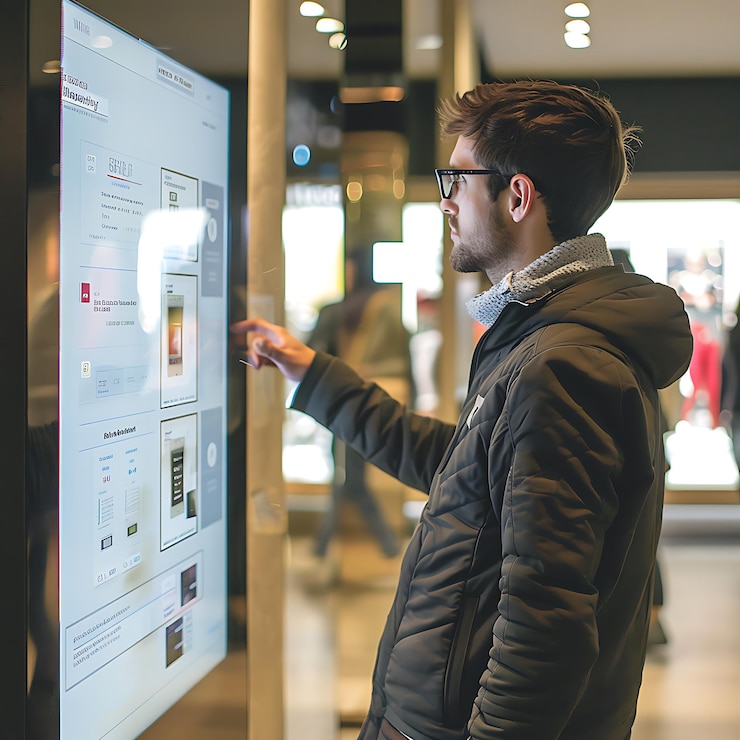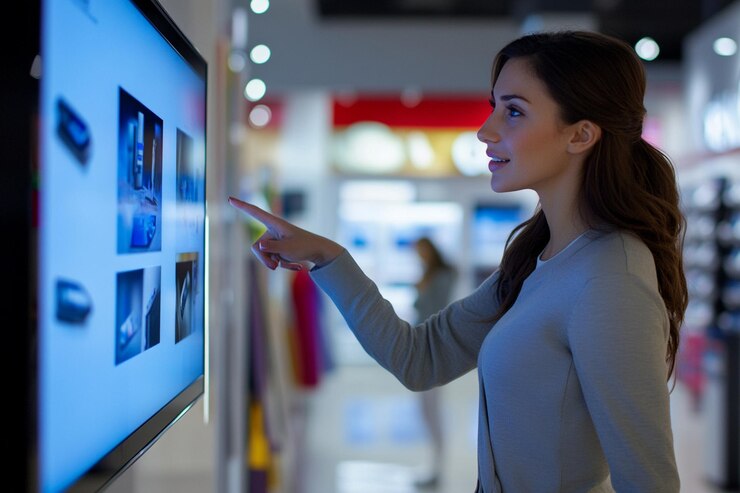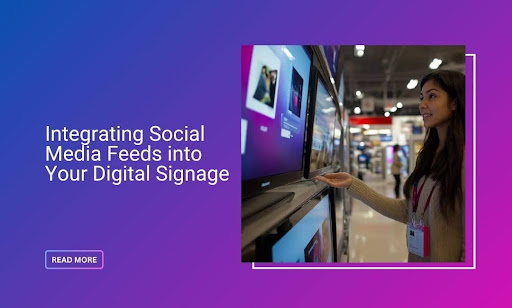People stare at screens all day long, but most digital signage still runs content that feels cold, disconnected, or irrelevant. Static promotions. Dated slides. Generic templates. All while users scroll through Instagram and TikTok right next to your display.
Here’s the uncomfortable truth: You’re competing with the feed. And the only way to win attention on a screen is to pull content from the spaces where people already engage — fast-moving, crowd-sourced, emotionally charged content. That’s where social media steps in.
If your digital signage isn’t pulling in social proof, live reactions, or community engagement, you’re not using it to its full potential. This isn’t about trends. It’s about traction — and how to use digital signage as more than a glorified slideshow.
This article will walk you through exactly how to do that, without making things messy or complex.
Here’s what we’ll cover:
- Why combine social media with digital signage instead of keeping them in separate silos
- Key benefits of merging live social content with physical digital displays (hint: attention and trust go up)
- How to set it up: tools, platforms, and design rules that keep your screen clean, curated, and legally safe
- What to watch out for: filters, content control, and brand safety
- How CrownTV makes integration simple, scalable, and flexible across locations
This is the playbook for turning your screens into something worth watching — and reacting to. Let’s pull the social content onto the signage and make people look up again.
Break the Wall Between Online Buzz and On-Site Screens
Most businesses treat screens in physical spaces as isolated tools — a place for slideshows, scheduled promos, or branded visuals. Meanwhile, their social feeds are lighting up with hashtags, comments, live reactions, and user-generated content that never touches the in-store experience.
That’s a missed opportunity. Keeping digital signage and social media separate slows down content flow, creates more work, and makes both channels weaker. You end up managing two different content calendars, building two different engagement strategies, and splitting your audience’s attention across two disconnected platforms.
When the platforms don’t talk to each other, your message gets split too. Merging social media with signage isn’t about chasing trends — it’s about aligning with how people already behave. Your audience isn’t separating “online” and “offline.” They scroll in one hand and look up with the other. Screens in physical locations should reflect that overlap.
One study found that most of the customers say user-generated content on screens makes them more likely to trust a brand. But most brands still keep those screens stuck in silos, running corporate campaigns while their social channels show what people actually care about.
Let that sink in. Trust is earned in the feed, not in a looped slideshow. So instead of managing these systems separately, it makes more sense to pull the content from your most engaged platform into the space where your audience is already standing. This move isn’t a gimmick — it’s a structural fix to a long-standing disconnect. And the best part? You don’t need to overhaul your content strategy. You combine what you already have and let it work harder across both screens.
What Happens When Social Feeds Hit the Screen

When live social content meets physical signage, attention shifts fast — and so does behavior. Here’s why the combination pays off:
- It pulls content from where people are already engaging. You’re not trying to build new interest from scratch — you’re extending what’s already working on your social platforms into your physical environment.
- It boosts perceived credibility without extra production effort. Social content, especially when it includes real users, reviews, or interactions, shows authenticity. It’s informal by nature. That’s exactly what makes it believable.
- It keeps the content fresh, automatically. Feeds change by the minute. That means your screen doesn’t get stale or repetitive. You’re not stuck in update purgatory, uploading new slides every few days.
- It makes people look up and participate. When people see real-time interaction on a screen, the barrier to entry drops. They’re more likely to use your hashtag, tag your location, or add to the conversation. That adds more content to pull in. And the loop keeps feeding itself.
- It extends the life of each post. A tweet or post that lives for an hour on a feed might get seen for days on a screen. That’s double-duty content — no extra work required.
When screens show social content, the experience feels more alive. More responsive. More human. That shift leads to stronger engagement, more brand loyalty, and faster response to the messages you’re trying to get across. And all of it comes from putting your best-performing content where more eyes can see it.
How to Pull Social Feeds Onto Your Screens the Right Way
Bringing social media content into your digital signage setup isn’t a plug-and-play task. If you want it to run clean, curated, and compliant, you need to follow a real system, not a shortcut.
Here’s how to get it right from the start:
1. Pick your source feeds carefully
Not all social platforms carry the same weight on signage. Each one brings a different format, audience intent, and content style, and that matters when the screen is visible to foot traffic.
Here’s a breakdown of practical fit:
- Instagram: Best for photo-first content, branded hashtags, location tags, and lifestyle visuals
- X (formerly Twitter): Works well for short-form quotes, reactions, live event coverage, and reposts
- LinkedIn: Suitable for professional content, awards, team recognition, and industry announcements
- TikTok/YouTube Shorts: Video content only works if your screens support audio and your audience has time to pause
- Facebook: Less relevant unless you’re targeting an older or local community
Don’t try to pull everything. Start with one or two platforms that align with your on-site audience. Then set content rules: hashtags to monitor, post types to allow, and brand-owned profiles to prioritize. The tighter the scope, the cleaner the feed.
2. Use a content aggregator to filter and queue posts
You never want live feeds running without moderation. Even branded hashtags can get hijacked, and one bad post can damage brand trust fast.
That’s where a social media aggregator comes in. These platforms pull in posts via:
- Hashtags
- Mentions
- User handles
- Location tags
- RSS or API feeds from verified accounts
But the real value is in manual and automated filtering. You should be able to:
- Pre-approve every post before it hits the screen
- Set keyword filters to block offensive or off-topic content
- Auto-hide duplicate posts or spam
- Blacklist certain users or tags that repeatedly violate quality thresholds
Tools like Taggbox, Walls.io, and TINT can support these functions. But even with automation, always set human oversight as your final gatekeeper.
3. Build clean templates that highlight the content, not the chrome
Design matters more than most teams realize. Raw social media content is chaotic — broken lines, emoji overload, clashing colors. If your template doesn’t structure that mess, the screen becomes unreadable in seconds.
Here’s what works:
- Single-post layouts only. Don’t cram multiple social posts into one frame.
- High-contrast backgrounds to separate the post from the environment
- Clear text hierarchy — handle, timestamp, and post content should never compete for attention
- Image containers that auto-crop or scale photos to a clean aspect ratio
- Fallback designs for text-only or broken-post situations
In screen-heavy environments like retail or transport hubs, include animation pacing rules — how long the post stays up, how it transitions, and whether user profile photos appear at all.
The design should guide attention, not distract from the post.
4. Stay legally covered with usage rights
User-generated content (UGC) is a legal grey area if you don’t handle it right. Displaying someone’s post on a public-facing screen without permission could count as unauthorized commercial use.
To stay compliant:
- Never display third-party content without consent unless the platform terms and your aggregator explicitly allow it
- Use opt-in UGC tools that obtain rights through DM or form submission (many aggregators offer this)
- Display only your owned account content if you want to skip the legal process entirely
- Avoid celebrity, political, or music-related posts unless you’ve secured broadcast rights
If your screens are in high-visibility zones — airports, malls, corporate HQs — legal exposure is even riskier. Work with legal teams or stick to first-party content to stay safe.
5. Use a signage platform that doesn’t fight the process
Social content is only as effective as your signage CMS allows it to be. You need a platform that makes scheduling, queuing, filtering, and deploying content fast, especially if you’re running screens across multiple locations.
CrownTV’s dashboard is built for exactly that. It’s a centralized control panel that lets your team:
- Push approved social content to selected screens or groups
- Schedule campaigns by hour, daypart, or event
- Update displays instantly without needing to be on-site
- Control permissions so that only certain users can push social media updates
- Separate social content from other playlists (menu boards, promos, wayfinding, etc.)
When the dashboard supports both content control and flexibility, your feed stops being a risk and becomes an asset.
6. Schedule smart — don’t overload the feed
More posts don’t equal more attention. In fact, content fatigue is a real problem. If posts flash by too quickly, people stop looking. If they linger too long, the screen feels stale.
Match your screen rotation to viewer behavior:
- High-speed environments (retail aisles, walkways): 10–15 seconds per post, max
- Waiting areas (lobbies, lounges, elevators): 20–30 seconds works better
- Event-based zones (conferences, brand activations): Tailor based on dwell time and screen size
Also, keep the feed fresh by mixing formats:
- Pull from different platforms (X, Instagram, LinkedIn)
- Alternate between post types (text, image, branded shout-outs)
- Highlight UGC separately from your own account content
And always review performance. If a screen gets skipped or ignored, adjust the pacing or content variety.
Don’t Let Social Content Derail Your Brand

Integrating live social feeds into digital signage can create momentum, but it also opens the door to risk. Without the right filters, controls, and review protocols in place, one bad post can undo months of brand-building.
Here’s what to keep an eye on if you want to keep your social media digital signage clean and on-message:
Content filters aren’t optional
Every aggregator or CMS should give you tools to filter posts before they hit the screen. But if you’re not configuring those filters correctly — or worse, not using them at all — you’re gambling with public content.
At a minimum, set up:
- Keyword blocks for profanity, competitor names, and sensitive topics
- User bans for known spam social media accounts or trolls
- Format filters to exclude unsupported content like GIFs, videos (if screens don’t play audio), or carousel posts
- Language settings to avoid social media posts in languages your audience doesn’t speak or understand
Make these filters part of your onboarding, not an afterthought.
Manual approval is still your best failsafe
Automated filters catch the obvious. But context matters. A sarcastic comment might pass every rule and still damage brand perception. That’s why human review is still critical, especially for:
- User-generated content
- Branded hashtags at live events
- High-stakes product launches
- Screens in public or regulated spaces (like healthcare or finance)
Use a manual moderation queue for anything user-facing. If your aggregator doesn’t support it, don’t run the digital signage content.
Brand alignment needs active supervision
It’s easy to treat social displays as decoration. But every post is a public endorsement. If a featured tweet has bad design, off-brand tone, or low engagement, it doesn’t help — it hurts.
To stay on track:
- Build a visual checklist: font size, tone, color contrast, brand-safe language
- Review all templates across screen types — what looks good on a vertical lobby screen might fail on a horizontal POS monitor
- Limit emoji use or platform-native shorthand that might not read well in a professional setting
- Rotate content categories — don’t let the same style of post (e.g., motivational quotes or giveaways) dominate
Someone on your team needs to own this — not once, but weekly.
Don’t skip the fallback plan
Sometimes, feeds break. Hashtag campaigns go quiet. Networks lag. Screens fail.
Always prep a fallback layer that kicks in automatically when:
- There’s no fresh content
- Filters block the entire queue
- Manual approvals are pending
- The aggregator loses sync
This might be a branded slide, static promotional image, or evergreen visual. But whatever you choose, build the safety net before things go wrong.
One System to Pull Every Screen and Feed Together
Managing digital signage integration across multiple locations can get messy fast, especially when you add live content like social media. Between syncing feeds, scheduling updates, approving posts, and tailoring what shows up where, most systems start to crack under pressure.
That’s where CrownTV steps in and keeps the whole operation smooth.
Control every screen, playlist, and feed through a centralized dashboard
Managing dynamic content across locations shouldn’t require individual logins, duplicated efforts, or constant phone calls with onsite teams. With CrownTV’s centralized digital signage software, your content team can control every screen remotely — from a single interface.
This isn’t a stripped-down CMS. It’s an enterprise-ready environment where you can:
- Approve, filter, and push curated social content to specific screens or screen groups
- Schedule content by minute, hour, daypart, or trigger event
- Isolate permissions so only verified users can control sensitive playlists (e.g., social media vs. corporate promos)
- View screen status and diagnostics to prevent blind spots in playback
- Manage dynamic overlays (QR codes, taglines, timestamps) layered over social media content
All updates push automatically. No site visits. No manual uploads. No FTP delays. Whether you’re managing 5 displays or 500, the same workflow applies — and screen-to-screen consistency is preserved. This centralized setup streamlines your marketing efforts while keeping your digital signage strategy aligned with your brand goals.
Deploy once, and scale without rebuilding infrastructure
Most systems struggle to scale beyond a few locations. CrownTV removes that ceiling. With its dedicated media player, you don’t need location-specific configurations, custom local storage, or IT intervention to add digital signage screens.
Each player arrives plug-and-play ready:
- Pre-configured for content sync via the cloud
- Hardened for 24/7 operation with secure OS lockdown
- Automatically connects to the CrownTV dashboard and pulls assigned content blocks
- Compatible with both Wi-Fi and Ethernet for flexible deployment
- Built to handle various social media platforms, live data feeds, and multimedia simultaneously without performance drop
This kind of flexibility is what allows your team to pull together content from social media channels and display it seamlessly across in-store digital displays, without rebuilding your backend every time your network expands.
Pull in dynamic social feeds through full app-level control
Static signage feels outdated fast. That’s why CrownTV offers full access to AppWorld — an extensive marketplace of content integrations that can pull data and feeds from wherever your audience engages.
You’re not locked into a one-size-fits-all template. Instead, you get:
- Engaging content tools for Instagram, X, LinkedIn, and more
- Widgets for review feeds (Google, Yelp), RSS posts, local events, and live metrics
- Custom modules that can showcase user-generated content with manual approval workflows
- Tools for overlay branding, time/date stamps, and moderation pipelines
These integrations support seamless integration between your screens and your social media efforts. When your content is centrally managed and easily adjusted, you can keep your messaging relevant while increasing social media engagement at the screen level.
Eliminate costly missteps with expert-guided installation support
A good content plan fails if your screens are mounted in the wrong place. CrownTV’s digital signage installation service closes the gap between content strategy and technical execution.
Every install is guided by experts who:
- Select the right screen type based on target audience behavior, venue layout, and screen visibility
- Map placements to maximize audience engagement and dwell time
- Plan routing to reduce clutter, downtime, and infrastructure costs
- Optimize screen angle, lighting conditions, and ventilation
- Configure every device for performance, not minimum compliance
The end result? A signage network that’s primed to enhance audience interaction, without guesswork. Each screen supports your broader marketing strategy, and every piece of integrating digital signage becomes easier to manage and harder to ignore.
Making Social Media Integration Easier Than You Thought
Bringing live social media feeds into your digital signage displays isn’t as complicated as it seems. When done right, it pulls double-duty content into spaces where people already pay attention — and turns your digital screens into something that actually gets watched. You’ve seen how the strategy works, why it matters, and what it takes to do it safely and at scale.
Let’s recap what you’ve locked down:
- Why separating social media and signage weakens both channels
- What you gain when you connect them — from attention to credibility to automation
- How to set it up the right way with aggregators, filters, and layout standards
- What risks to watch for when managing live, user-generated content
- How CrownTV helps you run this system across any number of screens, locations, or content types without breaking your workflow
Whether you’re looking to increase dwell time, boost customer engagement, or turn in-store screens into dynamic content hubs, this approach works. And when you’re integrating social media content as part of a larger digital signage solution, it strengthens both your messaging and your social media presence.
The next time you’re planning social media campaigns, think beyond the feed. With the right tools and system in place, that content can do a lot more — and go a lot farther — on screen.

